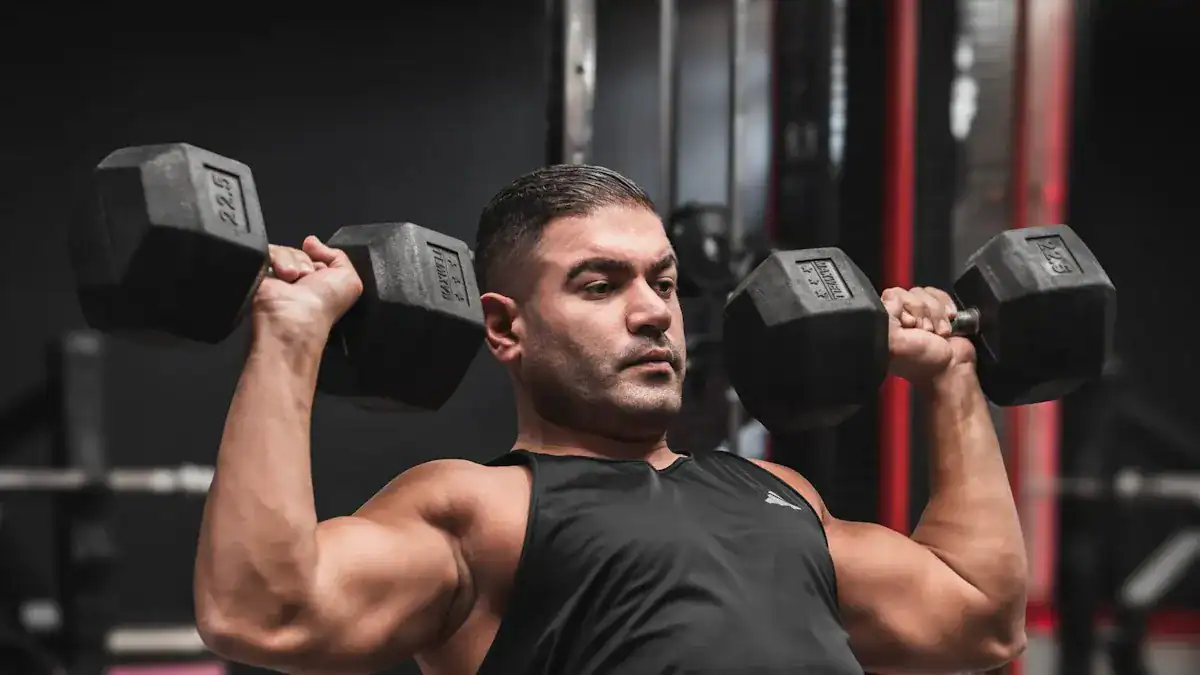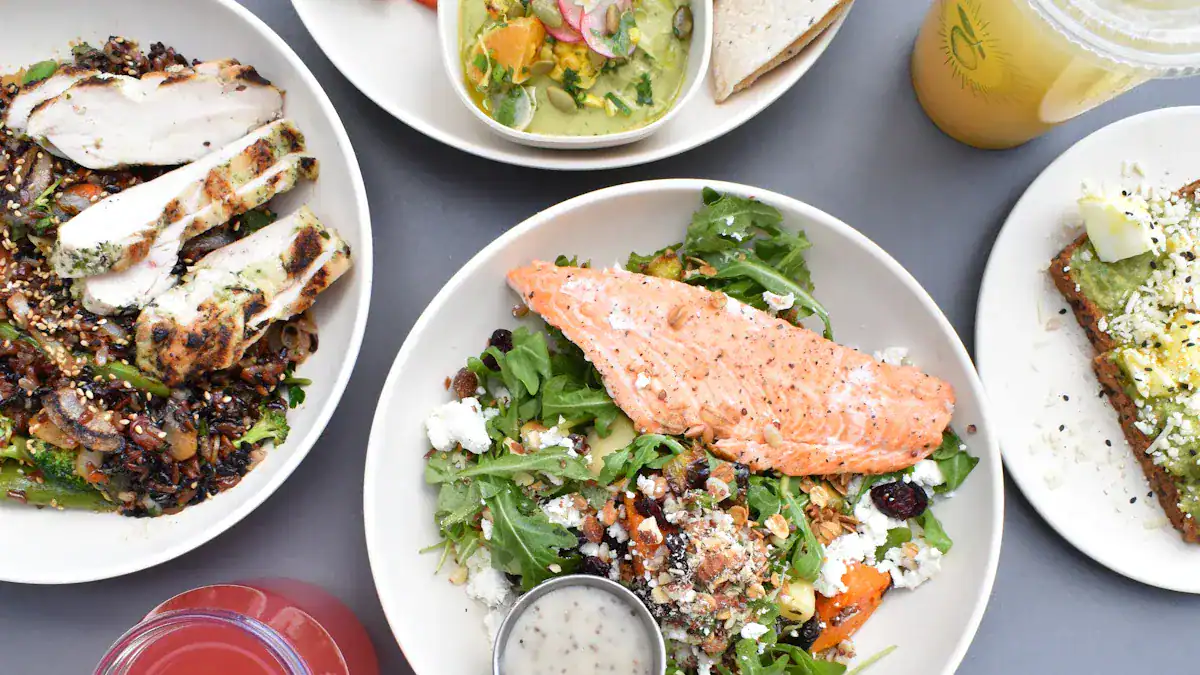
You want a strong body and lasting energy. Protein is crucial for achieving these. It aids in muscle building and provides sustained energy for your daily activities. The increasing demand for Protein-Packed Foods is evident, with the market projected to grow significantly at an annual rate of 8.43% from 2025 to 2034. This growth underscores the importance of protein. This blog highlights 15 excellent protein sources that can transform your diet, helping you meet both your fitness and energy goals. Discover how to easily incorporate more protein into your meals.
Why Protein to Build Muscle and Boost Energy

Protein’s Role in Muscle Building
You want a strong body. Protein is key to getting it. Your muscles are mostly protein. So, protein helps them grow and fix themselves. When you work out, especially with weights, you make tiny tears in your muscles. This is normal. Your body then uses amino acids. These are small parts of protein. They fix these tears. This repair makes your muscles thicker and stronger. This is how muscles grow. Eating enough protein helps this growth. It helps you get more muscle. If you don’t eat enough protein, your body can’t fix muscles well. It can’t build new muscle. You need to eat protein. This helps you get strong. It helps you get the body you want. Protein is very important for muscle growth.
Protein for Sustained Energy
Protein also gives you lasting energy. It’s not just for muscles. Carbs give quick energy. But it often doesn’t last. Protein digests slowly. This is good. It stops your blood sugar from going up and down fast. You get steady energy. You won’t feel tired in the afternoon. Protein also makes you feel full. You feel satisfied after eating. This stops cravings. It helps keep your energy steady. You won’t need snacks all the time. Your body uses protein for many things. It’s not just for fixing muscles. Eating enough protein gives your body fuel. It helps you do your best. It helps your body and mind. Protein gives you steady energy. You can do more each day. Protein is vital. It gives you physical power. It gives you lasting energy every day.
Top 15 Protein-Packed Foods

You want to fuel your body right. These 15 protein-packed foods help you build muscle and keep your energy high. They offer essential nutrients for your fitness journey.
1. Chicken Breast
Chicken breast is a top choice for building muscle. It is very lean. It gives you a lot of protein without much fat. This helps your muscles grow and repair after workouts. You can grill it, bake it, or shred it for salads. It is easy to add to many meals.
Here is how much protein different types of chicken offer:
Types of chicken | Protein per 100 grams |
|---|---|
Breasts | 32 |
Thighs | 25 |
Drumsticks | 24 |
Wings | 24 |
You can see chicken breasts lead the way.
2. Eggs
Eggs are a complete protein source. This means they have all nine essential amino acids your body needs. One large hard-boiled egg gives you about 6.3 grams of protein. They are also packed with other important nutrients.
Hard-boiled eggs offer various important nutrients, including:
Vitamin D
Zinc
Calcium
All B vitamins (particularly riboflavin/B2 and B12)
Phosphorus
Selenium
Vitamin A
Vitamin E
Lutein and zeaxanthin
You can enjoy eggs for breakfast, lunch, or dinner. They are versatile and affordable.
3. Greek Yogurt
Greek yogurt is a fantastic dairy option. It has more protein than regular yogurt. A 7-ounce (200-gram) serving of greek yogurt provides 20 grams of protein. This helps you feel full and supports muscle recovery. It also contains probiotics. These are good bacteria that help your gut health. You can eat greek yogurt with fruit, nuts, or in smoothies. It makes a great snack or breakfast.
4. Salmon
Salmon is a fatty fish. It gives you high-quality protein. It also provides healthy omega-3 fatty acids. These fats reduce inflammation. They support heart and brain health. A 3.5 oz (100 g) serving of salmon contains 2,150 mg of EPA and DHA combined. This helps your body function at its best.
Here is a look at omega-3 content in different salmon species:
Salmon Species | Omega-3s (per 3.5 oz / 100 g) |
|---|---|
King Salmon (chinook) | 2 grams |
Sockeye Salmon (red) | 1.2 grams |
Silver Salmon (coho) | 1.3 grams |
Pink Salmon (humpie) | 1.1 grams |
Keta Salmon (chum) | 2.1 grams |
You can bake, grill, or pan-sear salmon. It is a delicious way to get your protein.
5. Lean Beef
Lean beef is excellent for building muscle mass. It is rich in protein. It also provides important nutrients like iron, zinc, and B vitamins. These help with energy production and muscle function.
Lean beef offers key muscle-building nutrients:
Iron: Essential for red blood cells and physical growth. The iron in beef is easy for your body to use.
Zinc: Important for cell division, tissue repair, and your immune system. The zinc in beef is highly available to your body.
Selenium: An antioxidant that protects cells. It supports immune function and thyroid health.
B Vitamins (B2, B3, B6, B12): Crucial for energy and metabolism. Vitamin B12 is vital for your nervous system and red blood cells. Animal products are its main natural source.
You can enjoy lean beef in stir-fries, stews, or as a grilled steak.
6. Cottage Cheese
Cottage cheese is a dairy product. It is high in protein. A full cup provides 26 to 28 grams of protein. It mainly contains casein protein. Casein digests slowly. This gives your body a steady supply of amino acids. It is great before bed to help muscle repair overnight. You can eat it plain, with fruit, or as a savory snack.
7. Turkey Breast
Turkey breast is another lean protein source. It is similar to chicken breast. It helps with muscle growth and keeps you full. It is also rich in B vitamins. These vitamins are important for energy.
Turkey breast is a good source of B vitamins:
B Vitamin | Amount per 100g |
|---|---|
Folate (B9) | 55μg |
Niacin | 72mg |
Pantothenic acid | 6mg |
Riboflavin (B2) | 1mg |
Thiamine | 0.2mg |
Vitamin B12 | 2μg |
Vitamin B6 | 5mg |
You can use turkey breast in sandwiches, salads, or as a main dish.
8. Lentils
Lentils are a plant-based protein powerhouse. They are also high in fiber. A half-cup serving of cooked lentils gives you about 12 grams of protein and 8 grams of fiber. Fiber helps with digestion and keeps your energy stable. You can add lentils to soups, stews, or salads.
9. Quinoa
Quinoa is a grain. It is unique because it is a complete protein. This means it has all nine essential amino acids. These are amino acids your body cannot make on its own. Quinoa is notably rich in lysine and methionine. These are often missing in other grains and legumes. This makes quinoa an excellent plant-based complete protein. A cooked cup of quinoa provides about 8 grams of protein. You can use it as a side dish or in bowls.
10. Almonds
Almonds are a convenient snack. They offer protein and healthy fats. A 1-ounce serving provides 6 grams of plant-based protein. They also contain monounsaturated and polyunsaturated fats. These fats are good for your heart. They help reduce bad cholesterol. You can eat almonds raw, roasted, or add them to yogurt or oatmeal.
11. Oats
Oats are a great source of complex carbohydrates. They also provide protein and soluble fiber. Protein content in oat groats ranges from 13 to 20%. Soluble fiber helps lower cholesterol. It also keeps your blood sugar steady. This gives you sustained energy. You can enjoy oatmeal for breakfast. Add fruit or nuts for extra flavor.
12. Tuna
Canned tuna is a quick and easy protein source. A four-ounce serving of canned tuna in water contains 24 grams of complete protein. It also has omega-3 fatty acids. These fats are good for your heart, eyes, and brain.
Here is a look at the nutrients in canned tuna packed in water:
Nutrient | Canned tuna, packed in water |
|---|---|
Omega-3s | DHA: 56 mg, EPA: 8 mg |
Protein | 6 grams |
You can make tuna salads or add it to pasta dishes.
13. Edamame
Edamame are young soybeans. They are a plant-based protein source. A cup of boiled, shelled edamame pods contains about 18.4 grams of protein. They also provide fiber and other nutrients. You can steam them and eat them as a snack. Add a pinch of salt for flavor.
14. Chickpeas
Chickpeas, also known as garbanzo beans, are another excellent plant-based protein source. They are also high in fiber. A cup of cooked chickpeas provides about 14.5 grams of protein and 12.5 grams of fiber. You can add them to salads, make hummus, or roast them for a crunchy snack.
15. Whey Protein Powder
Whey protein powder is a popular supplement. It is a fast-digesting protein. This makes it ideal for post-workout recovery. A typical scoop of whey isolate protein powder generally contains between 20 and 25 grams of protein. You can mix it with water, milk, or add it to smoothies. It helps repair muscles quickly.
Incorporating Muscle Building Foods
You know which foods are rich in protein. Now, learn how to add them to your daily routine. This helps you build muscle and keep your energy high.
Meal Planning Tips
You need to plan your meals. First, define your protein needs. This depends on your weight, activity, and goals. Aim for 1.6 to 2.2 grams of protein per kilogram of body weight for muscle gain. Include many types of protein. Use both animal-based and plant-based protein sources. Examples of animal protein include chicken, fish, and Greek yogurt. Plant-based options are lentils, quinoa, and edamame. Combine protein with healthy carbohydrates and fats. This creates a balanced diet. Plan your main meals and snacks around these protein sources. You can use ‘One-Pot Wonders’ like stews. These help you use multiple protein sources easily. You can also repurpose leftovers. Turn roast chicken into a protein-rich salad. Make high-protein swaps. Use lentil pasta instead of regular pasta. Add affordable protein like cottage cheese to smoothies. This helps you get enough protein.
High-Protein Snacks for On-the-Go
Busy schedules need quick options. High-protein snacks are perfect for this. They help you stay energized. They also keep hunger at bay. Try nut butter with apple slices. Two tablespoons of almond butter give you about 7 grams of protein. Beef or turkey jerky is another great choice. One ounce offers 10-12 grams of protein. It is easy to carry. You can also make no-bake protein energy bites. These homemade healthy snacks contain about 6 grams of protein per bite. Other convenient savory high-protein snacks include edamame, canned sardines, and hard-boiled eggs. These options provide quick protein when you are out.
Portion Control and Timing
You need to eat the right amount of protein at the right time. Muscle protein synthesis is best when you eat about 20-25 grams of high-quality protein per meal. Aim for 0.4 grams of protein per kilogram of body weight per meal. Do this across at least four meals. This helps maximize muscle growth. Consuming protein after exercise is also important. It helps with muscle repair and reduces fatigue. Eating protein, especially essential amino acids, right after your workout can increase muscle protein synthesis. This helps your muscles recover faster.
You know about these 15 protein-packed foods. They help your muscles grow. They help you recover. They give you lasting energy. Start adding these foods to your meals. Do it slowly. Eat these foods often. This helps you get stronger. It gives you more energy. It makes you healthier. Remember, enough protein fixes muscles. This protein also gives your body fuel. You need protein to recover well. More protein helps you do better. Your body loves protein. Make protein important.
Eat well for long-term health. Focusing on protein will help you.




